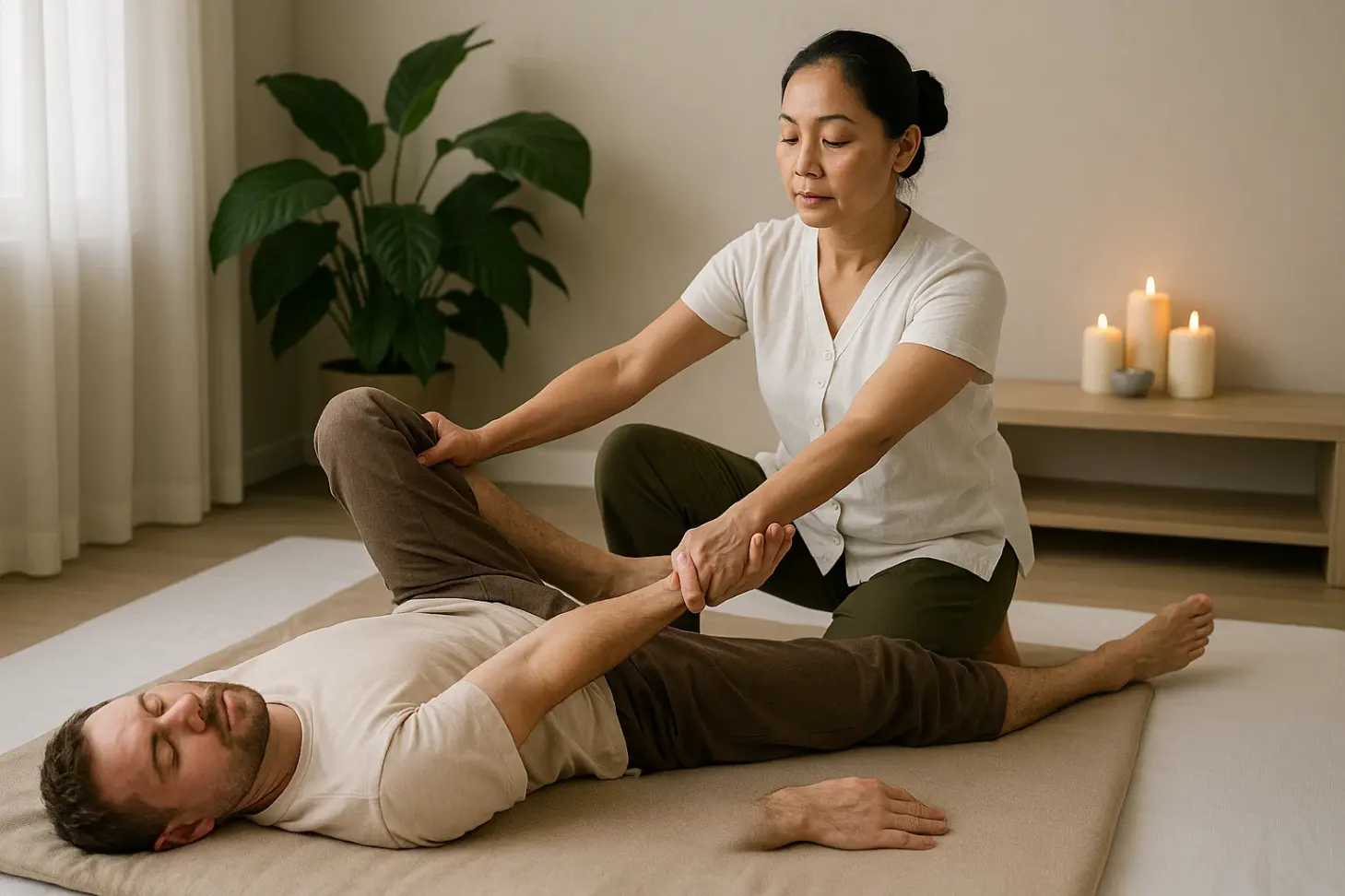In the fast-paced reality of the 21st century, where stress, anxiety, and sedentary lifestyles dominate, many people turn to alternative therapies in search of balance and well-being. Among these practices, Thai massage stands out as one of the oldest holistic techniques that has managed to adapt to the needs of modern individuals. It is praised as a therapeutic system that harmonizes body and mind, but at the same time, it is often surrounded by myths and misconceptions. To understand whether Thai massage is truly beneficial and how it integrates into contemporary life, it is essential to explore both its scientific foundations and its cultural background.
The Origins and Evolution of Thai Massage
Thai massage, also known as Nuad Thai, is a traditional healing practice that dates back more than 2,500 years. It is believed to have been influenced by Ayurveda, yoga, and Chinese medicine, combining elements of energy line manipulation, deep tissue pressure, and assisted stretching. Unlike Western massage, which often relies on oils and direct muscle kneading, Thai massage emphasizes body alignment, rhythmic pressure, and energy flow.
Over time, the practice evolved from temple rituals into mainstream wellness centers and modern spas. UNESCO recognized Thai massage as part of the world’s intangible cultural heritage, highlighting its importance not only as therapy but also as a cultural symbol. Today, its techniques are adapted to meet the demands of busy urban lifestyles, offering sessions ranging from 30 minutes of stress relief to two-hour deep restorative treatments.
Scientific Insights into the Benefits of Thai Massage

Research over the past decades has provided evidence for the multiple benefits of Thai massage. While traditional practitioners speak of energy lines or “Sen,” modern science explains its effects through improved circulation, musculoskeletal relaxation, and nervous system regulation. Clinical studies demonstrate that Thai massage can help reduce chronic pain, improve flexibility, and support recovery after physical exertion.
Furthermore, Thai massage has been linked to mental well-being. By lowering cortisol levels and stimulating endorphin release, it contributes to stress relief and mood stabilization. Athletes often use it as part of recovery programs, while office workers benefit from its ability to counteract posture-related tension. In a society where physical inactivity is a growing concern, the stretching and mobilization aspects of Thai massage act as a natural antidote.
Key Health Benefits Explained
- Pain management: Alleviation of chronic back pain, headaches, and joint discomfort.
- Mobility and flexibility: Gentle stretches improve range of motion and reduce stiffness.
- Stress reduction: Deep breathing and pressure techniques promote relaxation.
- Circulatory support: Enhanced blood and lymphatic flow boosts energy and immune function.
- Mental clarity: Reduction of anxiety symptoms and improved sleep patterns.
These benefits explain why Thai massage continues to attract both wellness enthusiasts and people searching for alternative health solutions.
Myths and Misconceptions Surrounding Thai Massage
Despite its popularity, Thai massage is often misrepresented. Some individuals mistakenly associate it with purely spiritual rituals or exoticized spa experiences, while others confuse it with unrelated practices. These misconceptions sometimes prevent people from recognizing its true therapeutic potential.
One widespread myth is that Thai massage is painful and overly intense. While it is indeed more dynamic than Swedish or aromatherapy massage, skilled therapists adjust pressure and stretching to the comfort level of each client. Another misconception is that Thai massage is only for the physically fit; in reality, it can be tailored to elderly individuals, pregnant women (with modifications), and those recovering from injuries.
To provide clarity, it is important to highlight the difference between myths and facts. Below is a contextual list that separates exaggerations from reality:
- Myth: Thai massage is just a luxury spa treatment.
Fact: It is a recognized therapeutic method with medical benefits. - Myth: The session is always painful.
Fact: Intensity depends on the therapist and client needs; it should never be unbearable. - Myth: It is unsuitable for older adults.
Fact: With adjustments, Thai massage is safe and beneficial for seniors. - Myth: Thai massage is only about stretching.
Fact: It includes acupressure, energy line work, and relaxation techniques.
By debunking these myths, the therapy can be better appreciated and integrated into contemporary lifestyles.
Thai Massage in the Context of Modern Lifestyle
The modern individual often faces challenges such as prolonged sitting, digital fatigue, and high levels of psychological stress. Thai massage directly addresses these issues, making it particularly relevant today. Sessions provide not only physical relief but also moments of mindful presence, reconnecting individuals with their bodies in a time dominated by constant digital distraction.
Corporate wellness programs are increasingly introducing Thai massage to reduce employee stress and improve productivity. In fitness communities, it is used as a complementary practice to yoga and pilates, enhancing flexibility and reducing the risk of injuries. Beyond physical benefits, Thai massage encourages deeper self-awareness, teaching people to listen to their bodies and respect their limits.
Comparative Overview of Massage Types
To illustrate where Thai massage stands among popular methods, here is a comparative table:
| Massage Type | Key Techniques | Best For | Intensity Level | Cultural Roots |
|---|---|---|---|---|
| Thai Massage | Stretching, acupressure, energy lines | Flexibility, stress, posture | Moderate to high | Thailand, influenced by Ayurveda & Buddhism |
| Swedish Massage | Long strokes, kneading, oil-based | Relaxation, circulation | Light to moderate | Western Europe |
| Deep Tissue Massage | Firm pressure, muscle fiber release | Chronic pain, athletes | High | Western therapeutic traditions |
| Shiatsu | Finger pressure, meridian work | Energy balance, relaxation | Moderate | Japan, rooted in Chinese medicine |
This comparison highlights Thai massage as a hybrid therapy bridging physical, energetic, and cultural dimensions, making it especially suitable for individuals searching for holistic wellness.
Practical Applications and Considerations
While Thai massage offers a wide range of benefits, it is important to approach it responsibly. Not all practitioners have the same level of training, and techniques may vary significantly depending on whether the therapist was educated in traditional Thai schools or modern wellness academies. Checking credentials and discussing health conditions before a session are essential steps for safety.
Thai massage is generally safe, but there are specific cases where caution is required, such as during pregnancy, after recent surgeries, or in the presence of severe cardiovascular conditions. For these groups, modified techniques or medical consultation are advised.
At the same time, one of the practical advantages of Thai massage is its adaptability. Sessions can be short and focused—ideal for office workers with limited time—or extended and immersive, offering profound relaxation and rejuvenation. This flexibility makes it an accessible therapy for people across different lifestyles and needs.
Integrating Thai Massage into Long-Term Wellness
For modern individuals seeking sustainable well-being, Thai massage can serve as more than an occasional indulgence. It can be integrated into long-term health strategies, complementing exercise, balanced nutrition, and stress management practices. Regular sessions encourage preventive care, addressing muscular imbalances and emotional tension before they escalate into chronic issues.
Moreover, Thai massage fosters a cultural connection to mindfulness and holistic health, reminding people that well-being is not just the absence of disease but the harmony of body, mind, and spirit. To maximize the benefits, it is helpful to view Thai massage as part of a broader lifestyle commitment.
Here is a contextual list of how individuals can integrate Thai massage into their routine:
- Include one session per month as part of preventive care.
- Use it after intense physical training or sports competitions for recovery.
- Combine it with meditation or yoga for enhanced body awareness.
- Explore both traditional and modern variations to find the most suitable approach.
- Discuss progress with the therapist to customize future sessions.
By doing so, people can transform Thai massage into a long-term ally for health and vitality.
Conclusion
Thai massage represents a bridge between ancient wisdom and modern needs. It offers a natural, non-invasive way to address the physical and emotional challenges of contemporary life, from chronic stress to posture-related discomfort. While myths and misconceptions persist, scientific research and cultural recognition confirm its therapeutic value. For the modern individual, Thai massage is not only a practice of relaxation but also a meaningful tool for resilience, self-care, and sustainable well-being.








